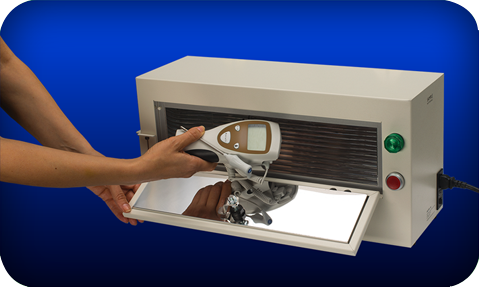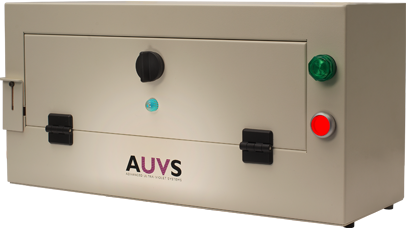COVID-19 The Smart Phone & Tablet Contamination Crisis
In the battle against Hospital Acquired and Surgical Site Infections (HAIs and SSIs) one of the most common first lines of defense seems to be a vigorously renewed focus on hand hygiene programs and compliance. The AUVS UV Box is tied to the hand washing issue. A few years ago some surveys, small and large, suggested clinicians had drifted away from compliance and thoroughness when it came to washing up. In response, reminders, improved awareness efforts and award winning poster programs sprang up at facilities across the country.
As noble as these efforts were and are, it does raise the question: How much progress can we possibly make if we scrub up, wash, use sanitizers and antimicrobials but then immediately pick up the most contaminated devices we could possibly find anywhere and continue to handle those devices all day and night? Will we do this at work, at home, in the car, in the OR, in the ICU, in the rest room, while eating, in the kid’s room until we go to sleep? Perhaps the biggest culprits ever of cross contamination may be our smart phones and tablets as supported by an ever expanding amount of authoritative literature. The AUVS UV Box solves this problem!
Our smart phones and tablets are never out of our hands and are used for everything personally and professionally as rapid hospital communication and EMR access become more dependent on them. They may be, in fact, the 21st century extension of our hands! Are we actually disinfecting these devices though? A recent video on CNN captures the risk of cross contamination very well. See our blog posted here. The AUVS UV Box is fast and effective and fits into our high paced environment.
Study after study, swab after swab, have proven that our smart phones and tablets are dirtier than a public bathroom toilet seat! COVID-19, E coli, C diff, Staphylococcus, MRSA, Streptococcus, Fecal Bacteria, the list goes on it’s like roll call of pathogens. They are all here. We know how important hand washing is, but don’t forget about the phone!
We still continue to wash up and pick up the dirty device! It doesn’t matter who we are, where we are, what patient or family member we are seeing and touching, what procedure we are starting, in the middle of or just completed our petri dish of a smart phone is in our hands. Our tablets almost as frequently. It’s OK, you can admit it.
Not me, I wipe my phone regularly!
Most people in Infection Prevention smile and shake their heads (sadly) at this defensive, hopeful response. They realize the practicality—or impracticality of wiping your smart phone for true protection. To achieve advertised decontamination rates, each side of our devices need to be thoroughly wiped and left wet for 3 minutes. If you handle it efficiently, that means: Wipe front and edges, wait 3 minutes, turn, wipe the back, wait 3 minutes. That’s 6 to 7 minutes, over and over again throughout the day and night. We can wipe our smart phones repeatedly but you aren’t getting the 99.99% decontamination promised because we just give it a quick wipe to ease our minds, not kill germs. Not that the wipes are defective or at fault, we just don’t and never will do it right. It just isn’t happening and every clinician knows it.
Smart Phones and Tablets
If our smart phones and tablets have become indispensable extensions of our hands, we need a better way equal in attention, importance and availability to hand washing.
According to Dr. Peter J. Papadakos of the University of Rochester Medical Center, who is an expert on the impact of technology on health care, a more nondestructive, rapid, user friendly way to decontaminate devices would be the use of UV technology.
UV is an easy, automated technology that does not need complex training programs and protocols, says Papadakos. It can be used by staff, visitors and patients to decontaminate hand-held electronic technology easily.
One solution already targeting small hand-held devices with UV technology is the KR615 Germicidal Enclosure from SPH Medical and Advanced UV Systems. Nicknamed “The UV Box” by clinicians, the KR615 has been adopted by more than 200 hospitals since its introduction less than two year ago. Small medical and non medical devices including smart phones and tablets are simply placed inside the enclosure, the containment door is closed and in less than 60 seconds 99.99% of the toughest to kill contaminants are sanitized.

The AUVS UV Box sanitizes the toughest to kill contaminants in less than 60 seconds
It can be used by staff and visitors in all hospital and clinical settings. Coupled with time tested hand hygiene this may be an affective weapon to fight against hospital acquired infection and cross- contamination in all clinical settings and units, says Papadakos.
Why is The UV Box the Better Mousetrap?
A number of factors suggests the UV Box could not only be the better mousetrap, but may be the magic bullet when it comes to addressing the smart phone and tablet cross contamination crisis.
Credibility: Developed by Dr. Wayne Clark, one of the nation’s foremost experts on antimicrobial UV applications, and based on the same technology he developed to protect the Pentagon against bioterrorism, The UV Box has been lab tested and proven to sanitize 99.99% of the toughest contaminants including C. diff and MRSA in less than one minute!
Ease of Use: There is no learning curve. Complete training takes about the same time as a single sanitizing cycle in less than 1 minute! Remember, no matter what the solution, the key is: Will it get used? No problem here with the AUVS UV Box.
Size: The UV Box is small only about the size of a small microwave. Countertop, wall-mounted, cart mounted, placed on a boom. It fits and can be moved virtually anywhere.
Mobility: Its size, weight, and availability in a rechargeable version means it can be placed where needed.
Durability: The KR615’s UV bulbs are conservatively projected to last 50 years! And they are guaranteed.
Affordability: With a very reasonable per unit cost under capital budget limits, this is the least expensive, proven solution available.
Accessibility: Its size, mobility and manageable price point means most hospitals can place The UV Box in multiple patient, staff and public locations. That means getting to it for frequent use will not be an issue.
The same level of accommodations made for hand hygiene (availability of sinks, antimicrobials gels, soaps and wipes) must be made for our mobile devices.
No One Trick Pony
While the concentration in this article is on Smart Phones and Tablets, the KR615 was designed to, and does, sanitize every small mobile device in your hospital – from Stethoscopes, Blood Pressure Cuffs and Blood Glucose Meters to Oximeters, TV Remotes and Nurse Call Buttons. In practical use, many clinicians also use The UV Box to sanitize personal items, including glasses, shoes, keys, IDs and wallets to reduce the risk of bringing dangerous contaminants home. The UV Box is at work for you without limits.

The UV Box targets all mobile medical and non-medical devices including smart phones tablets and personal items.
Summary:
- Hand washing is critical to our health and safety and the well-being of our patients and families.
- Our smart phones and tablets 21st century extensions of our hands are highly contaminated.
- The same level of accommodations made for hand hygiene (availability of sinks, antimicrobials gels, soaps and wipes) must be made for our mobile devices.
- In terms of practicality, effectiveness and affordability the small, mobile, easy to use The UV Box, is the answer.
